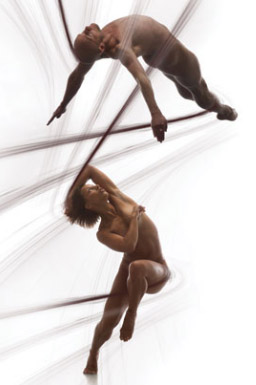
| HOME |
| NERVE |
| REVIEWS |
| ARCHIVE |
| EVENTS |
| LINKS |
| ABOUT US |
| CONTRIBUTORS |
| BACK ISSUES |
| CONTACT US |
 Crossing
Points
Crossing
Points
Presented by Phoenix Dance Theatre
Friday 23rd March 2012
The Liverpool Playhouse
Reviewed by Kathryn Lamble
The Liverpool Playhouse played host to Phoenix Dance Theatre as the company brought their new mixed programme of works to the city. Showcasing two premiers and two older pieces, the experimental and accomplished troupe displayed their commitment to challenging and engaging contemporary dance.
First on the bill was 2004’s Signal choreographed by Henri Oguike. Performed on an starkly lit red stage and accompanied by the insistent and urgent rhythms of Japanese Taiko drums, this piece was visceral yet fluid. The dancers were strong whilst also showing vulnerability through the fluidity of their upper bodies. The addition of bowls of fire at the back of the stage added depth and drama, while simultaneously providing an echo of the dancers’ bodies and lending an elemental feel to the dance. The performance was in turn thrilling and insistent and yet could lose focus at times.
Next was 2011’s Catch choreographed by Ana Lujan Sanchez and inspired by Rene Magritte’s painting Son of Man. This piece enjoys its status as the most obscure of the four; taking cues from its links to Magritte’s work in its surrealism and symbolism. I certainly took away a sense of an attempt in dance to make the static move. That they took their inspiration from one art form in Magritte’s painting and used that as a foundation from which to produce a very challenging example of contemporary dance; intricate yet daring and not without humour.
Thirdly came 2010’s Maybe Yes Maybe, Maybe No Maybe choreographed by Aletta Collins. Performed around a live microphone, this piece was more playful and focused more sharply on the dancers and their personalities. Street Furniture’s score is aided by the dancer’s voices, which are transformed into elements of the composition that drive the music and the performance. It often felt like the dancers created the sound and that sound in turn created them, defining their movements and how the audience received them. This was the most accessible, playful and humorous of the pieces and the most broadly entertaining.
The final piece was Kwesi Johnson’s SoundClash, which like Catch is a premier piece on this tour. It takes its inspiration from cymatics, the study of the patterns that sound waves make in the physical world. At the edge of the stage stood two pyramid-shaped light boxes projecting the waves that the soundtrack produced on water onto a screen at the back of the stage. This provided the setting for what proved to be an intense and inspiring final piece that blurred the boundaries between dance and physical theatre. The dancers were precise and intense, working together to articulate what could have become a confusing concept. They created a real sense that they were marionettes of the music, their bodies illustrating the nuances of the score.
A varied and exciting programme from Phoenix proves that they are serious players in British contemporary dance, unafraid of being entertaining whilst daring to challenge their audience.